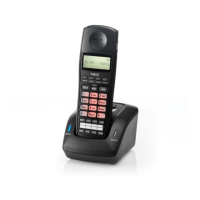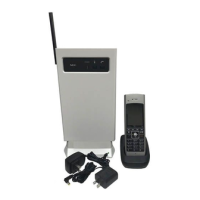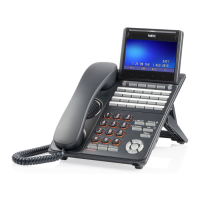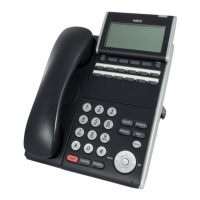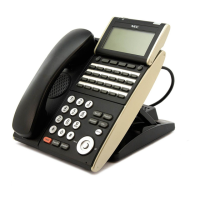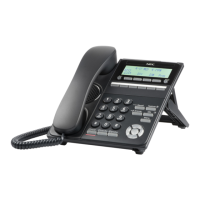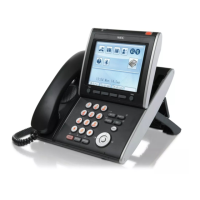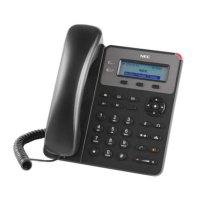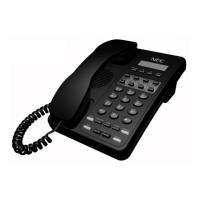
Do you have a question about the NEC Dterm IP and is the answer not in the manual?
Identifies key parts like LCD, Soft Keys, Programmable Keys, and dedicated function keys.
Identifies key parts like Call Indicator Lamp, Programmable Keys, and dedicated function keys.
Identifies key parts like LCD, Soft Keys, Programmable Keys, and dedicated function keys.
Identifies key parts like LCD, Soft Keys, Programmable Keys, and dedicated function keys.
Lamp flashes for call termination, steady for message.
LCD provides activity info, data, time, and Soft Key operation.
User can exit Help mode by pressing this key.
Features at LCD bottom are available via soft keys.
Explanations of Soft Keys can be called up on LCD.
Keys programmed as Flexible Line/Feature Key by admin for speed dialing.
Functions of Recall and Feature keys for setup and programming.
Keys for speed calling activation and voice mail access.
Functions of Mic, Conference, and Redial keys for communication.
Built-in mic and keys for adjusting volume/contrast.
Press key to answer a waiting call when LED is lit.
Controls built-in speaker for hands-free dialing/monitoring.
Allows call transfer and placing calls on hold.
Adapter for Dterm Series i 8D/16D/32D terminals.
Identifies key parts like LCD, Soft Keys, Programmable Keys, and dedicated function keys.
Keys programmed as Flexible Line/Feature Key by admin for speed dialing.
Functions of Recall, Feature, Directory, and Message keys.
Functions of Mic, Conference, Redial, and Microphone.
Adjust volume/contrast and answer waiting calls.
Controls built-in speaker for hands-free dialing/monitoring.
Allows call transfer and placing calls on hold.
Controls built-in speaker for hands-free dialing/monitoring.
Shows programmable keys and their functions for 16LD ADM.
Describes idle and call hold statuses and associated icons.
Describes incoming and exclusive hold statuses and associated icons.
Describes conversation and conference statuses and associated icons.
Describes active feature status and associated icons.
Shows LCD indications for programmable keys.
Shows LCD indications for One-Touch Speed Dial keys.
Allows registering telephone data from PC via USB interface.
Displays registered info and uses programmable keys for features.
Describes 16 additional programmable keys for Flexible Line/Feature Key.
Details registering telephone information and storing calling history.
Illustrates the rear connections of the Dterm4D IP terminal.
Shows rear connections for multiple IP Dterm models.
Describes the adjustable and removable base features.
Details the function of the quick disconnect button.
Illustrates the base of multiple IP Dterm models.
Details equipment for industry standard power methods.
Lists supported optional adapters and their descriptions.
Explains programmable keys and their functions, e.g., AICM, DICM, DND, FDA.
Functions of S&R, SIG, and NAME keys.
Describes Call Indicator Lamp, LCD, and Feature Key LEDs.
Details activities for Feature + keys 0-8.
Explains how Soft Keys adapt to telephone states and can be assigned.
Functions of Exit, Help, Mic, and DND soft keys.
Shows default soft key display for idle and dialing statuses.
Shows default soft key display for ringing status.
Shows default soft key display for busy and connection statuses.
Shows default soft key display for consultation hold status.
Call forwarding options: Busy Line, All Calls, Logged Out IP.
Features: Executive Override, Call Waiting, Call Back.
Message Waiting set/cancel and Call Hold functions.
Features: Call Pickup, Conference, Voice Call.
Features: System Speed Calling, Group Speed Calling, Privacy Release, DND.
Mic on/off, Page, Headset, and Release key functions.
SIG, CKEEP, SCALL functions.
IZP, IDCHG, GPICK features.
CHCNF feature to add a third party to a call.
VISIT and RMUTE functions.
Keys for scrolling through display screens.
Adjust handset volume using Up/Down keys.
Adjust speaker volume using Up/Down keys.
Adjust ringer tone using Up/Down keys.
Adjust LCD contrast using Up/Down keys.
Control microphone status and adjust handset receiver volume.
Select from 10 ringer tones using Feature+3.
Adjust T/R volume and activate/deactivate hands-free.
Turn call indicator lamp on or off during ringing.
Originate calls without lifting handset or pressing Speaker key.
Steps to log in to IP enabled terminals using login code and password.
Steps to log out from IP enabled terminals.
Steps to originate outside and internal calls.
How to originate and answer calls using multiline appearance.
Use One-Touch Speed Calling keys to originate a call.
Steps to program and verify One-Touch Speed Calling keys.
Shows character charts for One-Touch Speed Calling keys.
Procedure to enter and save names for speed dialing keys.
How to originate calls using station or group speed dialing.
How to program and operate system-wide speed calling.
Steps to find and call contacts in the 16LD ADM directory.
Shows how directory data is displayed and available characters.
How to make calls using the recorded calling history.
Procedures to enter account codes, with or without authorization.
How to use a forced account code for calls.
Procedures for entering authorization codes.
Steps to make and speak on a voice call.
Using soft keys to make voice calls.
How to answer a voice call hands-free.
Steps to initiate and answer automatic intercom calls.
How to bridge into an existing automatic intercom call.
Steps to initiate and answer manual intercom calls.
How to bridge into an existing manual intercom call.
Steps to initiate and answer dial intercom calls.
How to bridge into an existing dial intercom call.
Procedure to place a call on hold.
Procedure to place a call on exclusive hold.
Steps to transfer an ongoing call to another station.
Steps to initiate conference and broker calls.
How to answer a camped-on call.
How to program and activate call waiting.
Alternative ways to dial for call waiting.
Using soft keys for call waiting.
How to answer an incoming waiting call.
Steps to program a One-Touch Speed Calling key for call parking.
Procedure to park and retrieve calls from originating/remote stations.
How to use group and direct call pick-up.
Queues calls when outgoing trunks are busy.
Handles off-hook conditions when trunks are busy.
Allows overriding a busy station to bridge into a call.
Recalls the last dialed number or up to five previous numbers.
Procedure to set call forwarding for all incoming calls.
Procedure to cancel call forwarding for all incoming calls.
Procedure to set call forwarding when the line is busy.
Procedure to set call forwarding when calls are not answered.
Procedure to route calls to logged out IP stations.
Procedure to cancel call routing for logged out IP stations.
Set call back when the called station is busy or using soft keys.
Procedures to save and repeat dialed telephone numbers.
Steps to leave and respond to messages.
Procedures to access and initiate calls to the voice mail system.
How to page another station and answer paging calls.
Station A pages Station B to announce and transfer a call.
Station B answers to receive the call transfer.
Secretary's actions to transfer a call to the boss.
Boss's actions on accepting or refusing a transferred call.
Procedures to set and cancel Message Waiting indicators.
Program override key and secretary's steps for incoming calls.
Boss's actions in response to an override call.
Boss's actions based on different override scenarios.
Procedures to set and cancel the DND feature.
Redirects calls to forward or recall destinations using keys/soft keys.
Uses REDIR Soft Key for recall redirection.
Procedures to set and cancel the privacy feature.
Allows another station to enter an ongoing call.
Station A requests entrance into Station B's call.
Lists indications for callbacks, exclusive hold, and forwarding.
Lists indications for DND, FORWARD, and HANDS FREE.
Lists indications for HOLD, ICM, and INDICATOR O/OFF.
Lists indications for Login, Logout, LNR/SPD, etc.
Lists indications for MSG, MESSAGE BUSY, MESSAGE REST, etc.
Lists indications for OVERRIDE, PICK UP, PAGING, SPEED SET, TRANSFER.
Lists indications for T/R VOL, VOICE, VOICE BUSY/REST.
Prompt for privacy release at another station.
